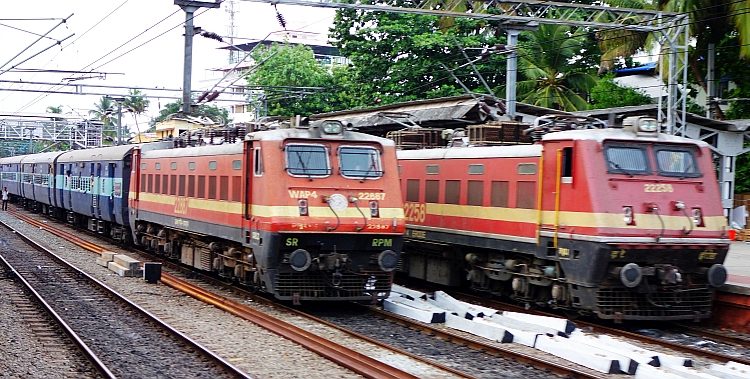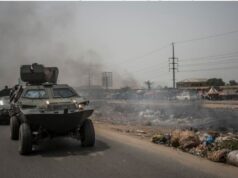Bandikui Revisited

If you travel 187 K.M. North West of Delhi, you reach Bandikui, a dusty town with magnificent buildings, churches, bungalows of Raj era. Bandikui was essentially a British township built by the early British Railway men.
One wonders what possibly necessitated British to choose, of all the places, Bandikui as their District headquarters of Railways in this part of India. Perhaps it is the salubrious Climate and smoother terrain of Bandikui which largely influenced the decision culminating into a settlement of not less than thousand Britishers Anglo Indians & Indian families.
It was during the reign of Queen Victoria that the Railways in India was getting deep rooted when Sir John Lawrence (1864 – 69) was Viceroy of India, Survey – an essential pre-requisite for laying Railway track was undertaken of Delhi – Jaipur – Ajmer and Agra. Jaipur- Ajmer Section.
His Highness Maharaja of Alwar, one of the first few students of Mayo College, Ajmer liberally donated the land for spreading Railway network linking his State with the Railway network. In 1865, land donation agreement was reached between Maharao Alwar and with Maharaja Jaipur in 1868.
To begin with, it was known as Rajputana – Delhi Railway, turned into Rajputana State Railway, converted into Rajputana-Malva Railway. Later in 1907, it was merged with BB&CI Railway Co. (Bombay Baroda & Central India). The then Government of India took over its management with effect from 01.01.42 and the suffix (Company) was dropped.
As a result of further rationalization and regrouping it came to be known as today’s Western Railway from 5th November 1951.
Initially the plans were proposed to construct Broad Gauge – (2.67 meter wide) something which India had to resort to much later under it’s much publicized /unique Uni gauge scheme as late as in 1990s.
Construction was undertaken in the superintendence of Col. F.S. STANTON, the Supdt. Engineer.
It was in the reign of Lord Northbrook, the Viceroy that the Delhi – Bandikui line was opened in December 1874.
Bandikui has had the singular distinction witnessing and passing through its territory the royal saloons of Prince of Wales, later Kind Edward VII 1874-1875, King George V, in 1911, Prince of Wales, later King Edward VIII 1921-22 and the Queen Elizabeth in 1961 on her way to tiger shoot at Bharatpur.
Initially, it was not Bandikui but Rajgarh which was proposed to be made a junction railway station between Agra & Jaipur and Delhi & Jaipur. When the team came for engineering survey the idea was given up due to number of hills to be crossed, therefore, Rajgarh was called unviable in 1885.
A fresh location was reached through engineering survey. Hills were blasted leveled in Mandavar. After that only, Bandikui became junction. The first person who studied in Mayo College, gifted his land for Bandikui, he was Raja of Alwar in whose memory Alwar gate has been erected in Ajmer.
One Mr. F.S. Young was S.P., U.P. subsequently became I.G. Jaipur, he was an active football player. European team was so popular those days that people used to come from far & wide to see the football match.
Playing tennis became a legacy. Everybody who was somebody wanted to learn tennis to be close to ‘sahibs’. In 1930 P.J.D. Janison was a prominent District Officer in Bandikui. It was in 1937 that Mool Narayan B. became the first Indian to get ‘overseas’ pay. An Indian recruited as Ticket collector would get Rs 30/- while no European/Anglo Indian was allowed to receive less than Rs.55/- ( Rs.25/- was Personal Pay) Later Parsis were also given this. Maximum pay of Ticket Collector was Rs.50/-. All three, i.e. Europeans, Anglo Indians and Parsis were at par regarding salary. No Indian was generally promoted to European grade.
First Indian, Rai Sahib Ganga Sahai of Rajgarh was the Station Master to have received European grade. Eventually, he retired at the pay of Rs. 400/- from Ratlam.
R.D. Gupta from Rajgarh was the first Guard to have got the European grade. First Indian to have been elevated to the coveted post of Traffic Inspector was L.N. Sharma (father-in-law of Dr Shankar Dayal Sharma, ex President of India) Vimla Sharma was educated in Railway school, Bandikui. L.N. Sharma was an M.A. in English literature way back in 1922.
There was perfect demarcation between the colonies of Indians and Europeans. European household generally would have following:
Khansama (Indian servant),
Bearer,
Masalchi,
Bhisty
And pet dog.
Dog would be familiar with Call boy (who delivers ‘position’ of train movements early in the morning) A type IV quarter of European railway man would consist of two bed rooms and two side rooms in addition to bathrooms fitted with portable commode. Each bathroom had night soil drum. Each bathroom had a scavenger.
Grocers prospered due to Anglo Indians. They seldom used to store/hoard. Every morning, khansama was given list of items to be bought. Khansama more often than not would bring commodities worth 4 aana and charge/billed 8 aana. (A packet of beedi,matchbox and 1 aana cash was the ‘gift’ from grocer to khansama for doing this). Be it grocer or khansama both became rich in no time, amusing is in no time they became poor also. A glaring example was of one Bohre Lal who rose to be a millionaire but his son Radhe Shyam had to earn his livelihood working as a Mazdoor (manual labor). Majority of Anglo Indians were perpetually in debt. They would get even their ‘fix’ of alcohol from railway run cooperative stores on credit. Clothes, eatables, almost everything was on credit. Unable to pay debt, they were slapped with attachment orders by the courts. At the time of their superannuation, often their retirement gratuity was utilized to set off against their debt. The popular saying those days was:
झांसी गले की फांसी, दतिया गले का हार
ललितपुर न छोड़िये जब तक मिले उधार
A British medico while nominating his wife as the beneficiary in the event of his death, wrote in his Provident Fund declaration “…in the event of my death amount may be paid to my wife ONLY when she re-marries…”
The church Prior to 1893 ‘service’ was conducted by the Bishop coming from Agra to Bandikui. In 1893 first church was established in Bandikui. Protestants wanting to become Catholic or vice versa were also baptized. First baptism took place on Nov 25, 1893 of Timothy Francis s/o William Angella Sinyum, Engineer, RMR by Father S.G. Nakotta. The church bears an interesting inscription
“In memory of Isabelle A.N. Godwyn who died in Alexandria on 2-3-1912. Kind words are the music of the world; this tablet was erected by her friends”
Freemason: On Delhi-Jaipur route the only Masonic lodge was in Bandikui. Masonic lodge’s foundation stone reads:
“This stone was laid by Dr William T.
4-3-1898
Lord Charity”
People will assemble from nearby places. The next Masonic lodge was in Ajmer only. They (Freemasons) were sworn to strict secrecy. After that only they could join the ‘brotherhood’. They would wear a distinct ring called Divider ring. They were sworn that they would not disclose to any one, not even to their wife about the concepts of Masonic faith. Mr Mool Narain B. was the first Indian in Bandikui who became member of the Masonic lodge.
World War II during war entire male population in reproductive age group was wiped out in Britain. In 1945, a retired Major from British Army ‘imported’ Indians and the first batch of 800 people (Punjabis) went to England. They worked in factories which were closed till then on the face of war strife. Another 1200 persons’ shipload went, again from Punjab. Needless to mention that these 2000 Indians, subsequently, imported their relations also. It is widely believed that 30% of British population today is of Indian origin.
Grave yard with unique epitaphs is a British legacy in their townships all over India. In Bandikui IOW (Inspector of Works) was required to keep ready coffin boxes in three sizes 6’, 5’ and 3’. On the event of death, ‘knell’ was sounded. All will assemble there. They would wait for 24 hours, one, waiting for near and dear ones to join, two, preparing the mortal remains for the final journey. This preparation included ‘make up’ perfume, tie, suit, cufflink, new shoes, walking stick and yes few bottles of whisky. IOW was responsible for smooth burial. Grave yard had a beautiful garden attached to it, tended by 4 gardeners and 2 wells. Here again, Indians were not allowed to carry their deads via the city/bazaar. In one such case, when Mr Tondon’s son died the funeral procession was being taken from the midst of city. The procession was almost arrested while being carried via court. It was only on the intervention of DTS (District Transportation Supdt.) that they were freed to proceed.
Shias were stricter than Sunnis. At every major Railway station there were two separate water huts for Hindus and Muslims. The Muslim one was called ‘sabeel ahale islam’ where Bhisty would fill water from masak (large bag made of goat skin)
My discussion was drawing to a close. Though Mr Kalyan Sahai Gaur had such a fascinating treasure of memories. He informed me with pride that serving Railways runs in his family, his family has a tradition of more than 100 years in Railways. In 1892 his father shri Bhairon Lal had joined Railways as a Brakesman at a monthly salary of Rs.10/- He retired from the post of Guard, Jaipur division in 1930.
When I expressed desire to leave, he said “not without lunch”. He insisted with such warmth, affection and respect that I could not refuse. His parting poetry about the sumptuous meal:
‘अपनी ही किस्मत का खाता है जहां में हर बशर
वो खाये तेरे घर या जा के खाये अपने घर
इसलिये मशक़ूर हो, तू अपने उस मेहमान का
जिसने खाया अपना खाना, तेरे दस्तरखान पर’
( _Based on discussions with a dedicated Railwayman, the late Kalyan Sahai Gaur, in the early 90s when the author was posted as Sr.DPO Jaipur.Bandikui was under JP’s jurisdiction)




